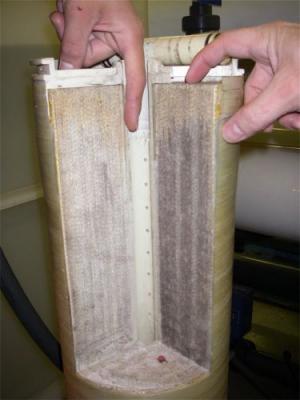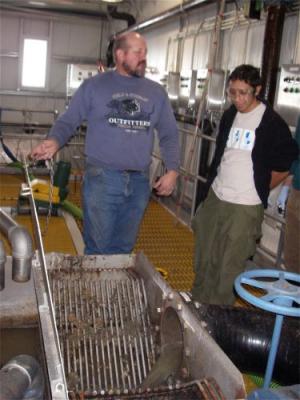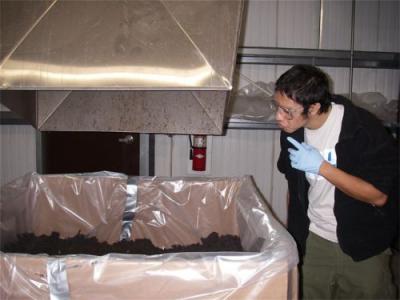Marcus and Stacy started the day with a dive that went down the dive hole in one Tomato and came up in the other one. This kept our divetenders of the day, Matt and Mandy, really busy!
First we chipped and dipped ice out of both Tomatoes.

Mandy chips ice

Matt chips ice
Then we moved all the dive gear into the first Tomato and got Marcus and Stacy in the water. Mandy monitored the first dive hole while Matt and I moved the gear to the second dive hole. We hauled a propane heater, two dive bags, the trays for the cameras, and a net to keep the hole clear of ice.
It was a lot of work, but the dive went well and they accomplished their goals.
After lunch we toured two important buildings in McMurdo: the water desalination plant and the sewage treatment plant.

Penguin Power and Water
Where do you think our water comes from? The sea! They pump water from 100 feet out at sea (under the ice) to the water plant. There the water is warmed using heat-exchangers. The heat is basically recycled energy - because it comes from the generators that heat the buildings at McMurdo. They warm the water from 28 to 36 F and store it in a tank. The water is then sent through filters made of anthracite (coal), sand, garnet, and gravel. This gets all the particles larger than 25 microns out of the water. Sometimes, jellyfish and pterapods (sea angels) clog the filter so it has to be cleaned out!

Nick and Bryan admiring pterapods that had been caught in the filters
Then they send the water through a 5 micron filter. 5 microns is 5 millionths of a meter, or 5 thousandths of a millimeter. That is really small!

Reverse-Osmosis filters
The water then has to be pressurized to 800 psi. PSI stands for pounds per square inch. Regular atmospheric pressure is 15 psi, so 800 is really, really high pressure! This forces the water through the reverse osmosis filters. Reverse osmosis filters don't let salt through the filters, so only water comes through and the salt is left behind. They have $80,000 worth of reverse osmosis filters in this treatment facilty.

Inside of the Reverse-Osmosis filter
The freshwater is then treated with chlorine and piped to all the buildings in McMurdo.
When you wash your hands, or go to the bathroom, the water then goes to the sewage treatment facility. The first thing that happens is it gets ground up by the "Muffin Monster" which has giant teeth inside to break everything apart. Then the fluid goes through a screen that catches anything the Muffin Monster didn't grind up enough.

Rick shows Nick the screen to catch debris from the sewage
The wastewater/sewage then goes to an anoxic (without oxygen) chamber, and then to a series of oxygenated vats.

The sewage gets aerated in a series of vats
There are lots of bacteria and protists that break down the sewage in the vats. This may look "gross" but it doesn't smell bad at all. And we have the "bugs" that are decomposing our waste to thank for a job well done.

Rick looking at healthy sewage microbes through the microscope

Bryan models how large the vats are
The vats fill a room the size of a gymnasium. The sewage treatment plant processes 60,000 - 70,000 gallons of waste water each day!
After treatment, the clean water that is removed is irradiated by ultraviolet light and then released into McMurdo Sound. Because it is freshwater, they mix it with the briny water that is "waste" from the desalination plant, so it goes back into the ocean as clean salt water.

The outtake pipe on the left goes into McMurdo Sound
The solid waste left behind is then compressed (more water is squished out of it) and it gets packed in plastic-lined boxes to go back to a landfill in the United States. About 70 boxes of human waste per year (at one ton each) end up leaving McMurdo on the one ship per year that comes in!

Nick admiring the "end result" of the sewage treatment process
The tours really gave us an appreciation of why we want to conserve water as much as we can!

